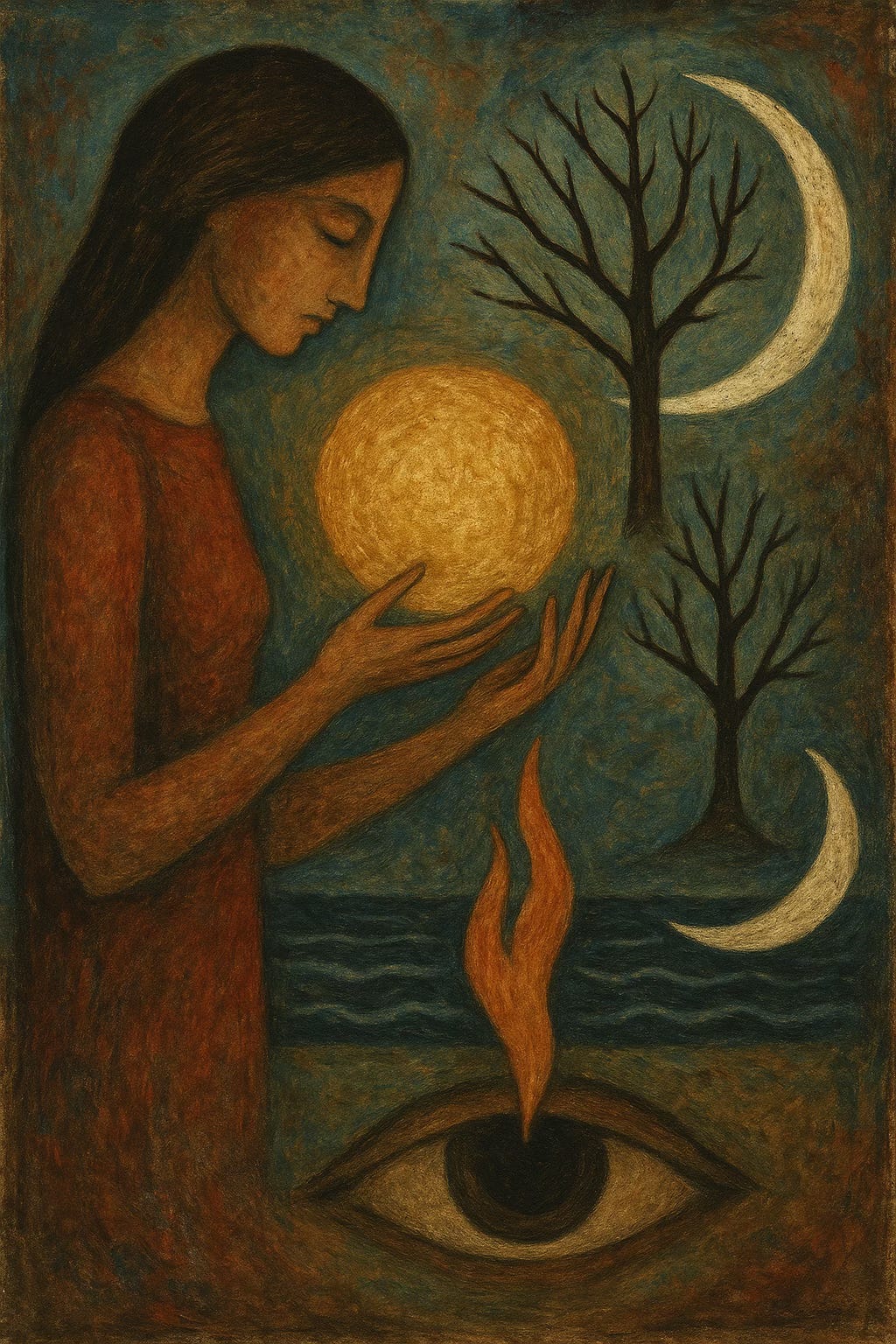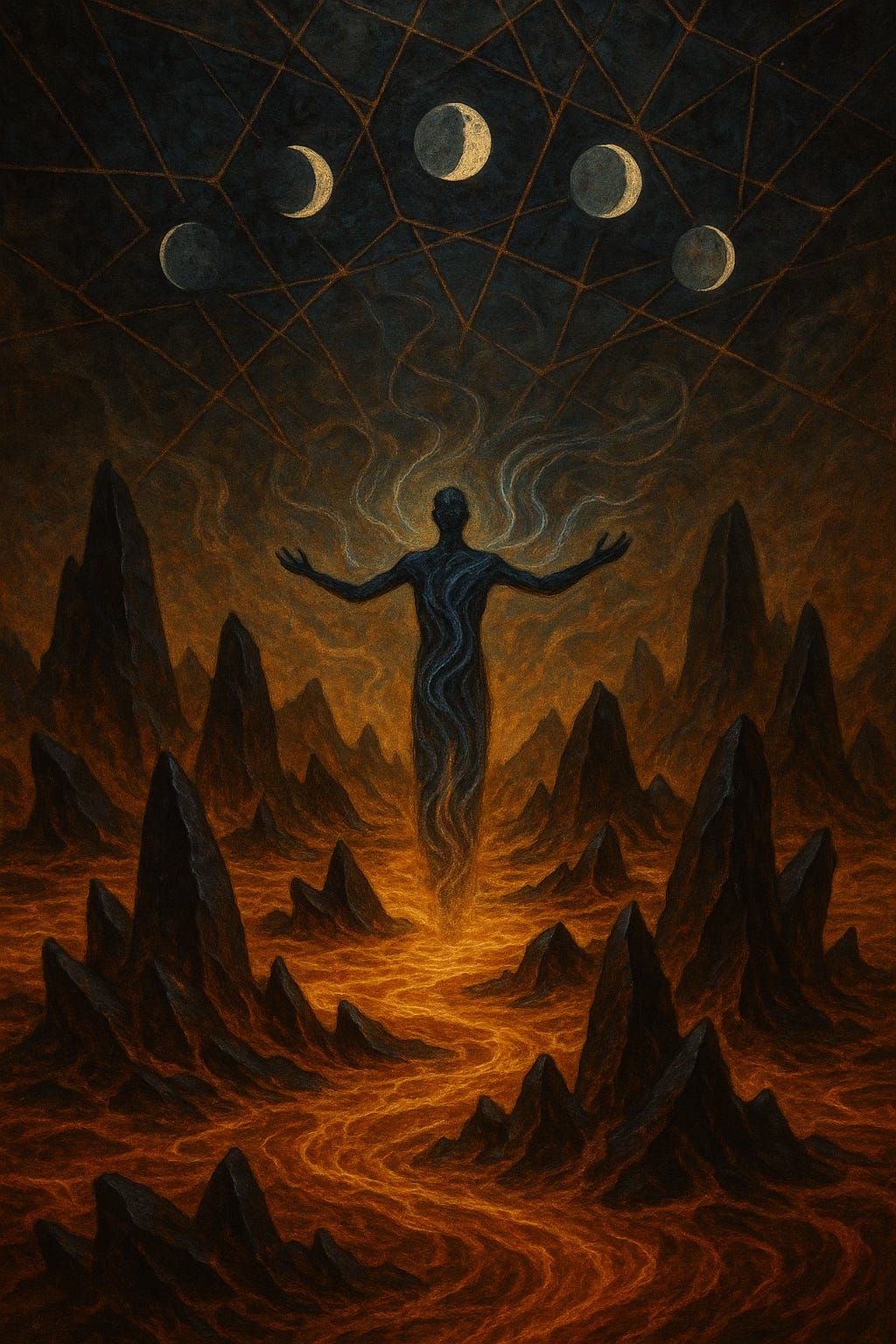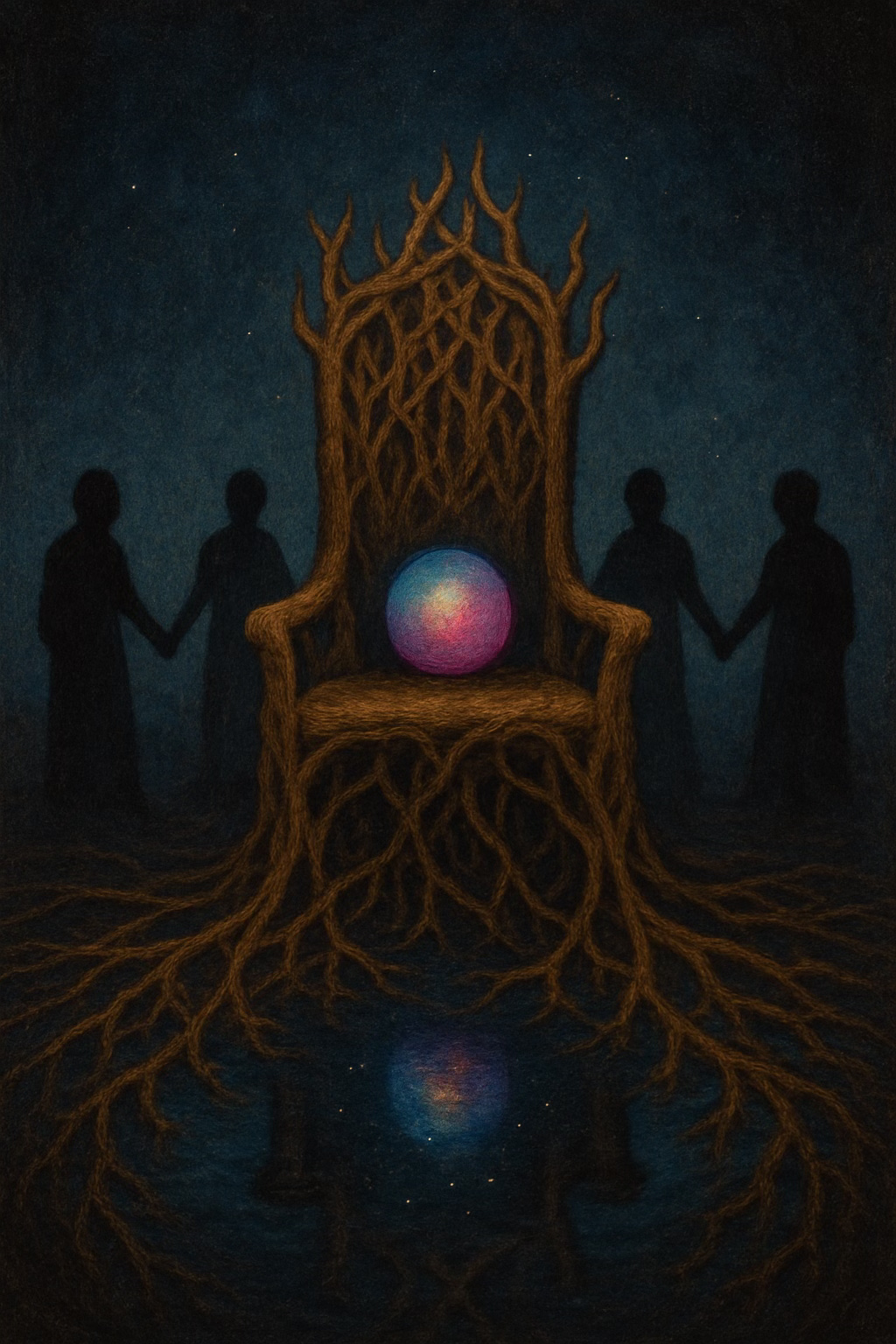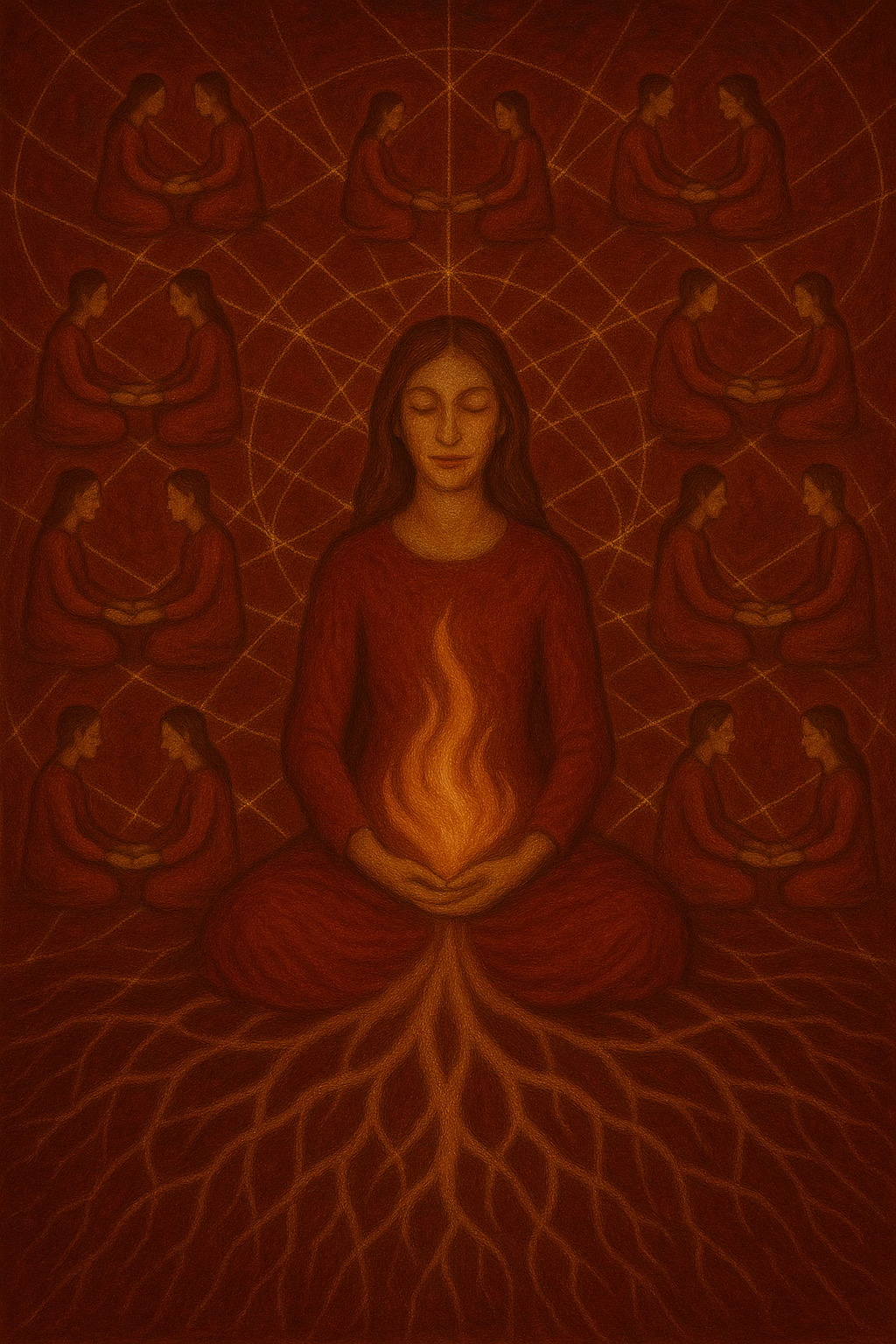Dedicated to Sophia and Christopher Life who originated this term and with whom I was first initiated into its deepest meanings through heartbreak and healing.
Disclaimer: This essay reflects personal insights applicable to both monogamous and non-monogamous relationships. Readers are encouraged to discover their own practice of human relating and take or leave whatever portions serve them. Whatever path you choose, human connection remains our greatest dojo for development—where we meet and master our most profound challenges and opportunities for evolution. Proceed with awareness and an open heart.
Introduction
We stand at a threshold. The crises we face demand not just new solutions, but a new way of being—what some call an ontological shift. As the old patterns of codependent relationships and patriarchal systems crumble around us, we're being invited into something ancient yet revolutionary: sovereign unity.
But let's be honest about where we are. Recent cultural conversations around non-monogamy and conscious relationships have revealed both profound possibilities and dangerous shadows. On one side, we see spiritual narcissism masquerading as enlightened relating—the ego co-opting sacred language to justify self-serving behaviors. On the other side, we see a reactive swing toward neo-traditional "divine union" models that promise safety through regression to rigid gender roles and conventional structures.
Both responses miss the deeper invitation. Sovereign unity isn't another relationship model or self-help framework. It's a recognition that we are not separate from each other or from the natural world—and that this recognition must begin with healing the fundamental split within ourselves. We are threads in a living tapestry, souls incarnating together to walk each other home and co-create a thriving planet for all. Our journey is to find our unique place in this web and contribute our gifts in service of life, beauty, goodness, and truth.
Beyond Karma
The path to sovereign unity begins with personal transformation—specifically, the dissolution of karmic codependent patterns and the recognition of our own inner non-duality. These patterns, rooted in personal, ancestral, or transpersonal trauma, drive us to seek completion through others or reenact behaviors learned through childhood wounding. We become trapped in cycles where we either rescue or need rescuing, dominate or submit out of fear rather than choice.
But here's what I've learned through years of painful unraveling: contained within our deepest wounds lies the blueprint for our healing and the seed of our unique gifts. When we stop running from our pain and instead turn toward it with courage, something alchemical happens. Our trauma transforms into wisdom. Our deepest hurts become our greatest capacity to serve.
Ancient alchemical traditions understood that healing begins with the recognition of inner union—the marriage of opposing forces, the anima and animus, within ourselves. What we call masculine and feminine energies are not gender assignments but archetypal principles that exist within every human being regardless of biological sex. The masculine principle governs focused attention, decisive action, and penetrating awareness. The feminine principle governs receptive wisdom, intuitive knowing, and the capacity to hold and nurture life.
True sovereignty emerges when we integrate these complementary aspects of ourselves rather than projecting one onto others. This is dharma—not just our life purpose, but the specific way our inner wholeness becomes medicine for the world. The man who learns to access his feminine wisdom becomes a more skillful leader. The woman who embraces her masculine fire becomes a more effective creator. Both discover that their apparent opposite gender expressions actually complete them.
As we resolve these ancient patterns and reclaim our inner wholeness, we discover something startling: we were already complete. We don't need others to provide what we lack. Instead, we can share our wholeness in service of something greater than ourselves. This is where sovereign unity intersects with what Thich Nhat Hanh called "interbeing"—the recognition that our apparent separateness is an illusion. We are not isolated individuals but expressions of one interconnected life.
Power
This inner transformation requires a fundamental shift in how we understand and wield power. Historically, traditional, hierarchical, and patriarchal relationships operate on power-over dynamics—one person dominates while the other submits, often unconsciously reenacting childhood patterns of abuse or neglect. The recent swing toward neo-traditional gender roles puts a new age spin on the same tired structures of colonial, imperial, mono-theistic pyramid of power: God rules over Man, Man rules over Women, Women rule over children. This same hierarchy has been used to justify slavery, imprison women from expressing their full agency, and spread Christianity worldwide through rape, torture, and genocide.
Sovereign unity invites us into something radically different: power-with relationships grounded in the recognition of non-dual consciousness. Rather than fixed gender roles based on biological sex, we embrace the dynamic interplay of masculine and feminine energies within ourselves and our relationships.
From inner wholeness, masculine energy (yang) expresses as outward attention—the capacity to attend to and serve life. Feminine energy (yin) expresses as receptive wisdom that guides yang energy into right action through the ability to feel into what's needed, inform through intuition, and to open to what wants to emerge. These energies are contextual and fluid. Sometimes men need to cultivate more receptive, flowing qualities. Sometimes women need to access more focused, decisive energy. The wisdom lies not in rigid roles but in conscious response to what each moment requires.
This understanding reveals the fundamental error in both traditional patriarchy and certain forms of feminism. Patriarchy devalued feminine energies in both men and women, creating a culture of disconnection and domination. Early feminism, while necessary for challenging oppression, sometimes fell into the trap of encouraging women to adopt masculine strategies rather than honoring the unique gifts of feminine wisdom. Both approaches perpetuate separation by suggesting that one archetypal energy is superior to another.
A metamodern approach to gender recognizes that both masculine and feminine principles are essential for wholeness—in individuals, relationships, and culture. We need focused attention and receptive wisdom, decisive action and intuitive guidance, penetrating clarity and nurturing presence. The goal isn't androgyny or the elimination of differences, but the conscious integration of complementary energies in service of life.
With the dissolution of patriarchal power structures and the emergence of power-with relationships, we enter into a dynamic dance between dominance and submission, yin and yang, and our relational behaviors and preferences also begin to shift. Individuals are no longer seeking to exert power over their partners in order to feel safe, but instead seek to work together in a way that honors and respects each other's needs and desires. This allows for a fluid and dynamic exchange of energy between partners, where both can take turns guiding and receiving guidance from each other.
The key is congruence—alignment between our inner state and outer expression. When we're incongruent, we might act dominant while feeling powerless inside, or appear submissive while harboring resentment. True power comes from knowing our inner state and expressing it authentically, creating space for a dynamic dance where partners can access different energetic qualities as the situation requires.
This kind of relating demands enormous trust and secure attachment. Trust built through honest communication, vulnerability, and consistent follow-through. Security created through a deep sense of belonging and safety. When we feel truly safe, we can release the need to control or manipulate others and engage in genuine co-creation that honors the full spectrum of human expression.
The Origin and Evolution of Monogamy
To understand where we're going, we need to understand where we've been. Monogamy isn't the "natural" human state it's often portrayed as. Its origins lie in the agricultural revolution, when humans began accumulating property and needed ways to ensure its inheritance.
Before agriculture, human societies were typically organized around kinship structures and communal ownership. But as people settled and accumulated wealth in land and livestock, the nuclear family emerged as a vehicle for transmitting property across generations. Women's bodies became a means of ensuring paternity and property rights. Patriarchy wasn't just about male dominance—it was a system designed to control and protect accumulated wealth. Monogamy emerged as a means of ensuring paternity and property rights, and women were relegated to the role of wife and mother, with limited autonomy or agency.
This system was reinforced by religious and cultural norms, then exported globally through colonization. European powers imposed their monogamous, patriarchal values on indigenous societies that had developed entirely different relationship structures and ways of organizing community life. These indigenous cultures often held more fluid understandings of gender and sexuality, recognizing the sacred interplay of masculine and feminine energies in ways that honored wholeness rather than separation. Many included third genders, expressions of their embodied cultural understanding of non-duality, who held the role of maintaining harmony across archetypes. Outside of the colonized worldview, a deeper look at human history reveals that humans have always engaged in a wide range of relationship structures and sexual practices, from same-sex relationships to non-monogamous arrangements and communal living. The imposition of Christianity, with its emphasis on monogamy and family values, was a key tool in this process, as it allowed European powers to justify the domination and exploitation of indigenous peoples and their lands.
Industrialization in the 19th and 20th centuries further accelerated the fragmentation of the village and the nuclear family became the dominant social structure in Western societies. The rise of wage labor and the separation of work from the home led to a further separation of the private and public spheres of life. This created a culture of fragmentation in which emotional and domestic labor was largely the responsibility of women, while men were expected to be the primary breadwinners. In this fragmented social system, men and women were enculturated to leave key aspects of human development undeveloped, with men never being expected to perform emotional labor and women never being expected to engage in productive agency.
The nuclear family, for all its virtues, has profound limitations. It places impossible pressure on two people to meet all of each other's needs. It isolates us from broader community support. It reinforces patriarchal power structures and limits individual autonomy. Perhaps most significantly, it perpetuates the inner fragmentation that keeps us from accessing our full range of human capacities.
In recent decades, we've seen the rise of feminism, LGBTQ+ rights, and alternative relationship structures like polyamory. These movements have been essential in breaking down oppressive norms. Second and third-wave feminism challenged women's exclusion from public life and economic power. These gains were necessary and important.
However, critics of modern feminism raise valid concerns when they point out that some feminist approaches encouraged women to succeed by adopting traditionally masculine strategies—competing rather than collaborating, prioritizing career achievement over relational wisdom, suppressing rather than integrating emotional intelligence. This wasn't feminism's fault; it was the inevitable result of trying to achieve equality within a system that only valued masculine expressions of power.
A metamodern feminism would go deeper, challenging not just women's exclusion from power but the narrow definition of power itself. It would recognize that feminine archetypal energies—intuition, collaboration, emotional intelligence, cyclical rather than linear thinking—are not consolation prizes but essential capacities for navigating complexity and creating sustainable cultures. It would honor the full spectrum of human expression while recognizing that different people may naturally gravitate toward different archetypal qualities regardless of their biological sex.
But both polyamory and the recent neo-traditional backlash have their own shadows. Polyamory, combined with dating apps and hookup culture, can become another form of consumer capitalism—treating relationships as commodities to be consumed rather than sacred bonds to be nurtured. It can enable avoidance of deep intimacy in favor of endless novelty. It can replicate the same competitive, scarcity-based thinking it claims to transcend. When spiritual language gets layered on top of these patterns, we see the emergence of what critics rightly identify as spiritual narcissism—the ego using sacred concepts to justify self-serving behaviors.
The neo-traditional response—a return to rigid gender roles and conventional marriage structures—offers the illusion of safety through regression but ultimately perpetuates the same inner fragmentation that created our relational crisis in the first place. By insisting that men must be always masculine and women always feminine, it denies the wholeness that ancient wisdom traditions recognized as essential for spiritual development.
Sovereign unity offers a different path—one that integrates the insights of both traditional commitment and conscious non-monogamy while transcending the limitations of each. It recognizes that the question isn't whether to be monogamous or non-monogamous, but whether we're relating from wholeness or fragmentation, consciousness or compulsion, service or selfishness.
Approaching open relationships with a deeper understanding of interbeing and a commitment to serving Life and the highest good of all, sovereign unity offers an evolutionary pathway for a healthy culture that is liberated from patriarchy while still rooted in the values of kinship and interbeing. Walking a narrow path between the wholeness of self and the wholeness of our relational fiends, practitioners of sovereign unity attempt to honor our individual sovereignty while recognizing our interconnectedness. Moving beyond karmic codependency and patriarchy while simultaneously addressing the shadows of polyamory, we open the space for secure attachment, the freedom to make choices aligned with our deepest desires and unique perspectives while taking full responsibility for the impact our choices have on others.
Sovereign unity is not about opening up to more partners or engaging in more sexual experiences. It’s about moving beyond codependent patterns and healing the wounds of attachment trauma. It’s about cultivating a deep sense of inner congruence, security, self-love, and self-awareness, while also honoring the interconnectedness of all beings. This is a foundation for healthy and authentic relationships, whether they are monogamous or polyamorous.
Returning to Kinship
At the heart of sovereign unity lies an ancient understanding: we are all kin. Not just humans, but all life on Earth. This isn't metaphor or sentiment—it's biological fact. We share DNA with every living thing. We breathe the same air, drink the same water, live under the same sky.
Indigenous cultures worldwide recognized this kinship and organized their societies around it. They understood that individual well-being is inseparable from collective and ecological well-being. They made decisions considering the impact on seven generations in the future.
Modern civilization has forgotten this truth, creating systems based on separation, competition, and exploitation. But as we re-awaken our remembrance of inter-being, we are called to step into right relationship and support one another in thriving. Returning to the underlying web of Life, we can see that our well-being is deeply interconnected with the well-being of our relationships and the world as a whole.
This return to kinship transforms how we see ourselves and others. Instead of isolated individuals competing for scarce resources, we become members of an extended family supporting each other's growth and flourishing. We begin to feel genuine joy at others' happiness (compersion) because we recognize their well-being as inseparable from our own.
As Jordan Siegel beautifully puts it: "Every living being sits upon the throne of its own selfhood, a throne created by a web of mutuality." Our individual sovereignty—our capacity for choice and self-direction—emerges from and depends upon our interconnection with all life. We are kings and queens of our own experience, but our kingdoms exist only within the larger ecology of relationship
.
This understanding dissolves the false dichotomy between individual autonomy and collective responsibility. True sovereignty isn't about getting what we want at others' expense—that's just ego masquerading as empowerment. Real sovereignty emerges from recognizing our interdependence and choosing to act in ways that serve the whole while honoring our unique gifts and perspectives. It's the marriage of masculine individuation and feminine connection, creating something more beautiful than either could achieve alone.
A Metamodern Worldview
This vision of sovereign unity aligns with what cultural theorists call metamodernity—a worldview that transcends the limitations of both modernism and postmodernism. Where modernism offered universal truths and postmodernism deconstructed all claims to truth, metamodernity embraces paradox. It holds multiple perspectives simultaneously. It is both sincere and ironic, individual and collective, rooted and fluid.
Metamodernity recognizes that we need shared meaning-making practices while honoring diverse perspectives. We need both individual sovereignty and collective responsibility. We need to embrace both the universal truths that science reveals and the particular truths that emerge from different cultural contexts. We need both masculine clarity and feminine wisdom, both focused attention and receptive awareness.
This isn't relativism—the idea that all perspectives are equally valid. Some worldviews create more suffering than others. Some relationship patterns are healthier than others. Spiritual narcissism that uses sacred language to justify harmful behavior is not equivalent to genuine devotion that serves life. But it's also not fundamentalism—the belief that only one perspective is true. The world is complex enough to hold multiple valid ways of understanding and organizing human life, and wise enough to discern between approaches that serve wholeness and those that perpetuate fragmentation.
Family as Devotion to the Sacred
In sovereign unity culture, families form around shared devotion to what matters most. These families may include biological relatives, chosen family members, romantic partners, close friends, and spiritual companions. What unites them isn't genetics or legal contracts but aligned values and mutual commitment to growth and service.
At the center of these family constellations lies devotion to the sacred—however each family defines it. For some, this might be God or Goddess. For others, it might be love itself, truth, beauty, the Earth, or the evolution of consciousness. What matters isn't the specific form this devotion takes but its centrality to the family's identity and decision-making.
This shared devotion becomes the gravitational center that holds the family together through inevitable conflicts and challenges, providing a filter and grounding rod for the formation of more complex social units and bonds. When human personality clashes or old wounds get triggered, the family returns to their shared values and vision. What serves love? What serves life? What serves the sacred work we're here to do together?
Without this transcendent center, families practicing sovereign unity often fragment. I've seen many attempts at alternative family structures collapse because they lacked a unifying vision strong enough to weather the storms of human complexity.
A Lifelong Developmental Practice
Sovereign unity isn't a destination but a practice—one that requires developing specific capacities over time. These skills can't be learned intellectually; they must be embodied through consistent practice and real-world application.
Authentic Communication means expressing our truth without blame, criticism, or manipulation. It involves speaking from "I" statements, owning our experience, and listening with genuine curiosity rather than defensiveness. This isn't about being "nice" or avoiding conflict—it's about engaging conflict consciously and skillfully.
Emotional Responsibility means taking ownership of our emotional experience without making others responsible for managing our feelings. When we're triggered, instead of attacking or withdrawing, we pause and ask: "What is this reaction teaching me about myself? How can I use this as an opportunity for growth?"
Secure Attachment begins with developing security within ourselves. We learn to comfort ourselves when distressed, celebrate ourselves when joyful, and provide ourselves with the steady love and acceptance we may not have received as children. From this foundation, we can offer others the gift of our presence without needing them to fill our emotional holes.
Discernment involves distinguishing between our projections and perceptions, our needs and preferences, our trauma responses and authentic responses. Internally, it means knowing what's ours and what belongs to others. Externally, it means choosing relationships and situations that align with our values and support our growth.
Trauma Alchemy is perhaps the most challenging and essential capacity. It involves recognizing how our past wounds show up in present relationships and consciously choosing different responses. Instead of unconsciously reenacting old patterns, we use our triggers as doorways to deeper healing and wisdom.
Preference Communication means expressing what we want without attachment to getting it. We share our desires as information rather than demands, creating space for collaborative solutions that serve everyone's needs.
Compersion—joy in others' joy—challenges our conditioning around scarcity and competition. When our partner experiences pleasure or success with someone else, instead of jealousy or threat, we feel genuine happiness for their flourishing.
Co-sensing involves tuning into the larger field of relationship and making decisions that serve the whole rather than just our individual preferences. This requires tremendous trust and mature development—the ability to temporarily set aside our personal desires in service of what wants to emerge collectively.
All-Win Solutions go beyond compromise to find creative third options that honor everyone's deepest needs. This isn't always possible, but it's always the aspiration—seeking solutions where no one has to sacrifice their essential well-being for others' happiness.
These capacities develop slowly, through practice and often through painful mistakes. There are no shortcuts. Each person must walk their own path of healing and development, supported by others on similar journeys.
Conclusion
Sovereign unity is a transformative process that offers a path towards healing and liberation for ourselves and for society. As an ongoing practice, all who choose it are destined to be transformed and evolved in the fire of choosing love over fear.
Sovereign unity is not a perfect system or final answer. It's a lived experiment in conscious relating, an attempt to evolve beyond the relationship patterns that have created so much suffering while honoring the wisdom they've also carried. It rejects both the spiritual narcissism that uses sacred language to justify selfish behavior and the regressive traditionalism that promises safety through the suppression of our full humanity.
This work is hard. It demands everything of us—our willingness to face our shadows, heal our wounds, and show up authentically even when it's uncomfortable. It asks us to love not just the easy parts of ourselves and others but the difficult parts too. It invites us to see every conflict as an opportunity for deeper intimacy and every trigger as a doorway to greater freedom. Most challengingly, it requires us to embrace the paradox of being both individual and interconnected, both sovereign and interdependent, both masculine and feminine in our wholeness.
I offer these insights not as someone who has mastered this way of being but as a fellow traveler still learning, still growing, still making mistakes and cleaning them up. The path of sovereign unity is walked not by perfect people but by ordinary humans committed to extraordinary love—love that transcends the ego's demands and serves something greater than our individual desires.
My deepest prayer is that these ideas contribute to the healing of human relationships and the creation of cultures that support all life to thrive. May we move beyond the false choices between selfish freedom and repressive tradition, between spiritual bypassing and fundamentalist reaction. May we find the courage to embrace our full humanity—our capacity for both focused attention and receptive wisdom, both individual expression and collective service, both the yang fire of creation and the yin waters of compassion.
May our children inherit a world where love is not just an ideal but a lived reality that shapes how we organize our lives together—not through the suppression of our complexity but through its conscious integration in service of life.
The future of human relationship is not predetermined. It's being created by every choice we make, every conversation we have, every moment we choose wholeness over fragmentation, consciousness over compulsion, service over selfishness. We are the ancestors future generations will thank—or blame—for the world we leave them.
May we choose well.













Oneness in diversity. Thank you ~ ♡